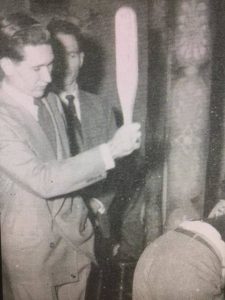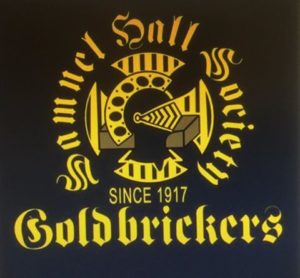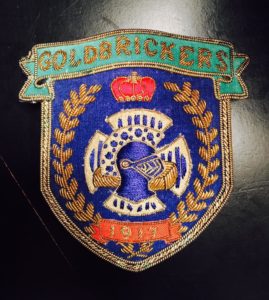There is always a better way…
The story of Gold Brickers
When in 1928, Brigham Young University established the social system on the campus, the Gold Bricker Social Unit was among the first to affiliate. It became known as Unit No. 1. This, however, was not the birth of the Brickers, for this club was already 11 years old. Other social fraternities had florished on the campus earlier but none as early as the Bricker unit.
The story of Gold Brickers began near the close of World War 1, or, we might say even before that; for the foundation of the club was built on a life-long frienship of a group of young men. The formal organization of Brickers had its first stirrings of life on the tiny peninsula that helps form San Francisco Bay where the famous old Army fort, the Presidio stands. In May of 1917 a group of Brigham Young University students along with other college students in the Rocky Mountain and Pacific Coast areas were ordered to Officers Training Camp at the San Francisco Army Fort. The Y men, most of them boyhood friends, were scattered throughout the many companies, yet they kept close touch during a summer of intensive training.

At the conclusion of this period of training the fellows were ordered to report back to Pravo for induction into the S.A.T.G. which was being installed on the campus by the government. Here, because of their previous training, the officer "trainees" were used to assist in the training of other students who enlisted in this unit. Two companies were organized: one with barracks in the Maeser Building and the other in the Ladies' gymnasium.

It was during this time that the Gold Brickers Club called "Nuggets" at this time.
Twelve men drew up the Gold Bricker Charter
A number of the men, who had by now added their west coast experience to their college and High School memories, were more frequently meeting together and pooling their funds for parties and outings. Gradually, and quite naturally, the men had formed a closely knit group. They recognized this fact and it was then , in the fall of 1917, that the announced the formal organization of the Gold Bricker Club. The name obviously grew fron the familiar army term. The little fraternity had evidently mastered the art of by passing the routine durdgery during their army days and had revived the term for a more lofty pupose in civilian life.

Twelve men drew up the Gold Bricker Charter. They elected a president, vice president, secretary and treasurer. Those Fellows who make up the charter member list are: Clarence O. Edwards, Ralph B. Keeler, Rulon S. Dixon, Elmer Baddeley, Glen Crandali, Grant Grandall, Reed H. Holt, J. Lyman Brown, Lyn D Taylor, Vernon C. Talboe, J. Aldous Markham and M. R. Taylor.
The charter members, who helped shape many of the patterns, ideals and traditions of the club, did not plan a professional or honorary fraternity, for their chosen fields were varied. Their excuse for forming the club was based on three qualities they all had in common- high ideals, a thirst for success, and a sincere desire for fellowship. Most for these men were outstanding in student politics, athletics, debating or some othere school activity. Through the years, the men who have worn the Gold Bricker Shield, in most cases, have done.
Gold Bricker Club was a youngster
so under the same qualifications and purposes as the founders. Above all, Brickers, have shared and cherished the fellowship of this social fraternity.
The Bricker unit was successful and popular right from its infant days when the White and Blue, student newspaper on the campus reserved a full column for the club to report its activities. The unit was active in all school functions whenever possible.
But these happy days on campus were not a last. As other clubs began to develop at the school, so also did abuses of the university's rules and standards. This resulted in the banishment of all clubs from the campus in 1923. The Gold Bricker Club was a youngster of 6 at the time. But this did not dissolve the unit for it was an organization built on more than rules and codes. The Brickers continued off the campus in much the same manner as they had operated as a part of the school's social system previously. They held their parties, dances and athletic competition. In fact, they held a special activity in condemnation of the "banishment". The Brickers held a formal party publicized as the "Gold Bricker funeral."
Elaborate ceremonies ensured, when all the members dressed in mourning, gathered around an actual coffin containing a large gilted brick. The party was held on Saturday night, the next day was Easter and appropriate resurrection ceremonies were held by Brickers who had just graduated. They reorganized the club at this time to fit the off-campus situation. Of course those members still in school were silent partners, but took part in all parties and assessments.
Bricker Social Activity
This fact seems evident that the club is personified by the average all-around good fellow. The Bricker unit has been highly active in all school and social unit competition functions. It has in the past won the annual AWS Song fest, copped top honors in the Homecoming Float competition, presented assemblies, won first prize in the early pep vodies that were once the preview to all BYU, Utah games. The unit has always respected and supported school causes and activities.

Social activity of the unit itself is based on nine major parties each school year. Aside from rush parties and initiation activities functions consist of : Invitational Dance, in which members invite friends to semi-formal dancing party: Bricker formal dinner dance, one strictly formal party of the year in which members and alumni enjoy dinner and dancing in formal atmosphere: MisFit, costume dancing party always the most hilarious spree of the year; Spring Festival, three days of activity at Bricker Haven in Provo Canyon-hiking, swimming, eating, sports, etc.: Annual Senior Banquet, usually held in conjunction with the Spring Festival where the club bids farewell to graduating members; Bricker-Tausig Bury the Hatchet Party, the two units spend a week in competitive sports climaxed by rope pull and dance; Annual Post-Prom; Annual All-Night New Year's Eve Party, members greet new year in various activities; and Annual Thanksgiving Dinner and Dance, founders day activities. The unit holds any other party members wish.

One basic reason for the Gold Bricker Social Units Success is the emphasis placed by the club on activity. In fact, the unit constitution designates only three kinds of membership: active , any person who has been initiated and is attending school; absent, a person who has been initiated and is in good standing but is not attending school and alumni, members who have graduated from Brigham Young University. Any member may be disfellowshipped whi violates the constitution or by a unanimous vote of the active members.

During the past years the unit has taken difinite steps to organize a broad active Alumni group other than the Gold Bricker Country Club. Form letters were sent out in 1948 to hundreds of Bricker alumni throughout the country. The results were gratifying. Not only did the returned forms indicate that Bricker alums were among an extremely successful portion of the population, but that all of them were interested in belonging to an active alumni group. Men from all walks of life answered the Bricker call. A Washington attorney, mayor of a large Arizona city, manager of a large retail store in Kansas City, college dean, architect, farmers, bankers, contractors, college coaches, are only a few that appear on Bricker alumni files.
Bricker initiations have been known to be the toughest on the campus. This is one tradition that has stuck through the years. They were never meant to be mean or cruel nor have they been taken that way by the yearly goat classes. The whole initiation is based on the idea that something must be worked for to be of value or to be cherished. All members who have gone through the week of initiation activities, which means absolutely all members- constitution stipulates that membership requires one week of traditional goating will attest to its effectiveness.
The Golden Rule
The Gold Bricker shield sums up in five dramatic points the life and fiber of Brickerhood. This shield which has never been changed since its origin, is made up of knights head, gold brick and a cross. Its meaning, however, is much more comprehensive.
The twelve black bars, forming the background of the shield represent unity and brotherhood, as characterized by the twelve charter members.
The Gold Brick represents the Golden Rule: "Do unto others as you would have them do unto you."
The helmet signifies honor and chivalry.
The six opals represents the six carinal points of the Bricker Code: Individual growth, Sociability, Refinement, Scholarship, Fellowship, and Morality.
The cross of the shield represents reverence to God.
Although modern day Brickers are constantly striving to improve and build their unit, they hold steadfastly to the ideals and traditions of the charter members and above all, to the Gold Bricker Code, the application of which has been an inspiration to active members and alumni for more that three decades.



